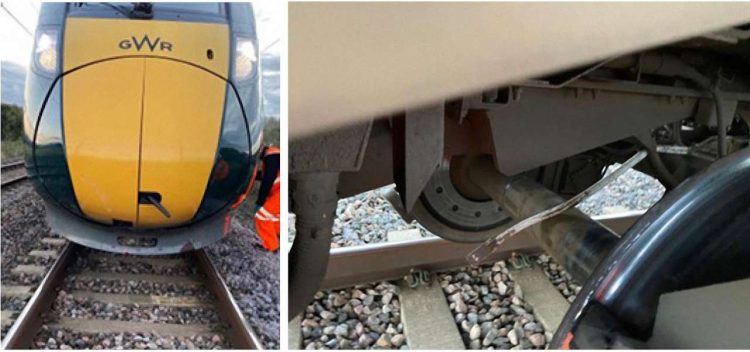The Rail Accident Investigation Branch (RAIB) has released its report into a collision between a passenger train and a hand trolley at Challow in Oxfordshire Last year.
At 06:09 on 21st October 2021, a passenger train travelling at 123 mph struck a hand trolley on the track near Challow, Oxfordshire.
Maintenance work had been carried out overnight, and the train was the first to pass through the area after the completion of the work. None of the passengers or crew on board suffered injuries, and the train did not derail.
The impact destroyed the trolley, and debris from damaged equipment under the train and caused minor damage to the track.
A maintenance team had carried out overnight work at Challow and no one noticed the team had left its hand trolley on the track.

Network Rail
Checks undertaken before the railway was handed back the railway for normal operation did not identify the trolley's presence. Part of the checks was the line clear verification process which monitored what vehicles, including hand trolleys, were placed on and taken off the track during the overnight work. However, this process had weaknesses, which were compounded by the maintenance team not following the required process on the night concerned and relied on human actions for its integrity.
The underlying factors relating to weaknesses in the line clear verification process were:
- Its integrity relied on human actions, because although the rail industry had recognised it as a weakness, no measures had been implemented to avoid or mitigate errors.
- It was included in the work planning process as specified by Network Rail's company standards.
- Network Rail's assurance activities had not detected that staff in the welding and grinding section of the Swindon delivery unit were not complying with the line clear verification process.
- A further probable underlying factor was that hand trolleys were routinely used at night without displaying any red lights, and no assurance activities were undertaken within work sites to monitor compliance with this requirement.
- The Rail Accident Investigation Branch observed that after the accident, given the level of damage the train had sustained, it could travel at a speed above that which should have been permitted. The RAIB also noted that there were multiple issues with how Network Rail had planned the work at Challow.
Five recommendations were made to Network Rail:
- Establish how the existing line clear verification process can be improved.
- Consider what technology its staff could use to support the process.
- Amend the Rule Book so that it is a requirement for hand trolleys to display an illuminated red light in both directions at all times when on the track.
- Implement processes to ensure that any hand trolley placed on its track has illuminated red lights displayed in both directions.
- Review the effectiveness of Network Rail's safety assurance activities which check that hand trolleys are being used correctly and safely.
The RAIB also identified three learning points:
- Remind maintenance staff about the importance of complying with all rules and standards concerning how trolleys and rail skates should be used on Network Rail's infrastructure.
- Ensure there is clear communication between staff at a train involved in an accident and staff in control rooms to establish what damage has been sustained by a train, and make sure appropriate controls are put in place before the train is permitted to move.
- Ensure that staff involved in planning maintenance work produce documents that are accurate, appropriate, and specific for the task that is being carried out, and involve those responsible for the work in its planning.
Andrew Hall, Chief Inspector of Rail Accidents said: “Systems and processes designed to detect any equipment left on the track before lines re-open after maintenance work, should not be reliant solely on human performance in the middle of a dark night. There are technological solutions which can assist with addressing this issue, and this accident is an example of an opportunity missed.
“Our investigation found that the railway had identified the risk of equipment, such as hand trolleys, being left on the line and that it could mitigate this risk by improving the line clear verification process. However, it had not yet implemented the changes required when this accident occurred. This meant that the process remained vulnerable to human error. In this case, this vulnerability was made worse because relevant procedures were not followed correctly. Technology has an important role to play in improving the safety of the railway and it is important that the development of solutions to better support staff are prioritised.
“It is also a concern that hand trolleys were routinely being used on the track at night without displaying red lights. But it is of equal concern that no activity to monitor this requirement was being undertaken. Once again, assurance activities intended to check that rules are being followed and that processes are being implemented correctly were not effective.”
The driver ran at 85 mph post incident, based on intuition, do the maths for normal brake performance with 2 coaches isolated, plus build up time/ inertia? Compare this to Appendix C signal spacing distance. (Emergency is not for normal running, so not considered)
The driver regarding the Edinburgh sleeper incident couldn’t comprehend 8 coaches not providing any braking effort, what does this say about driver training and competence?
I would have thought that the presence of the trolley on the line would have caused track circuiting to show ‘line blocked/occupied in the signalling centre, so that signals would not be able to be cleared for any train to enter the section??